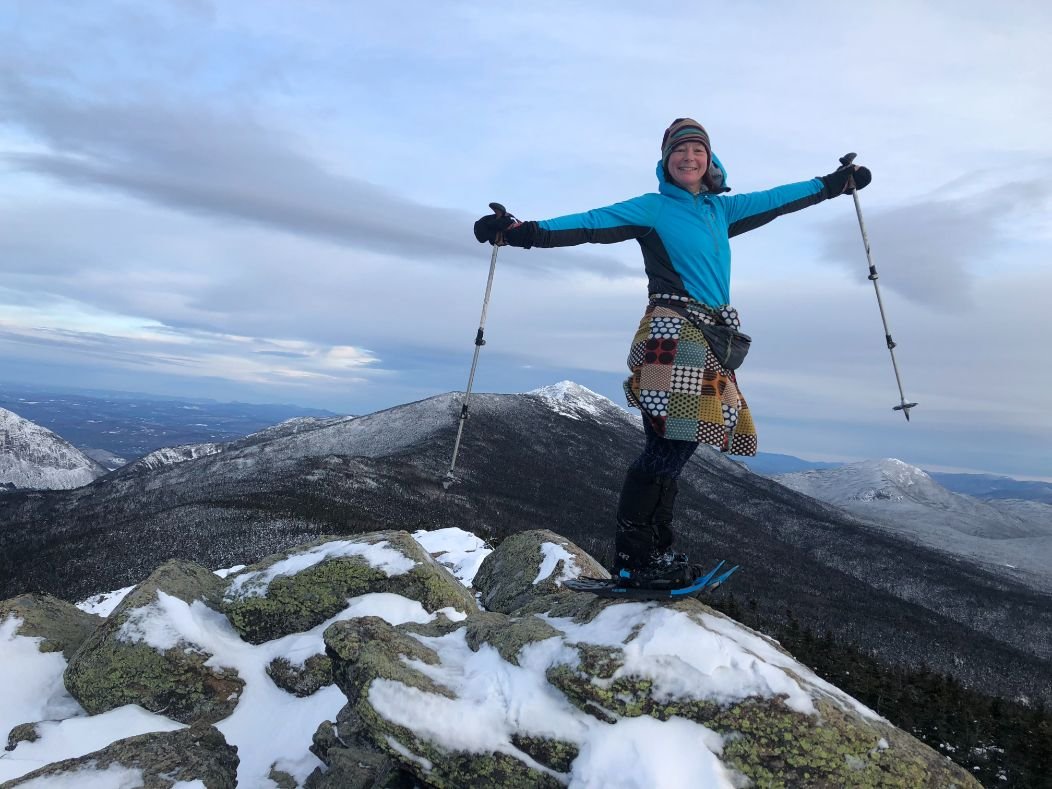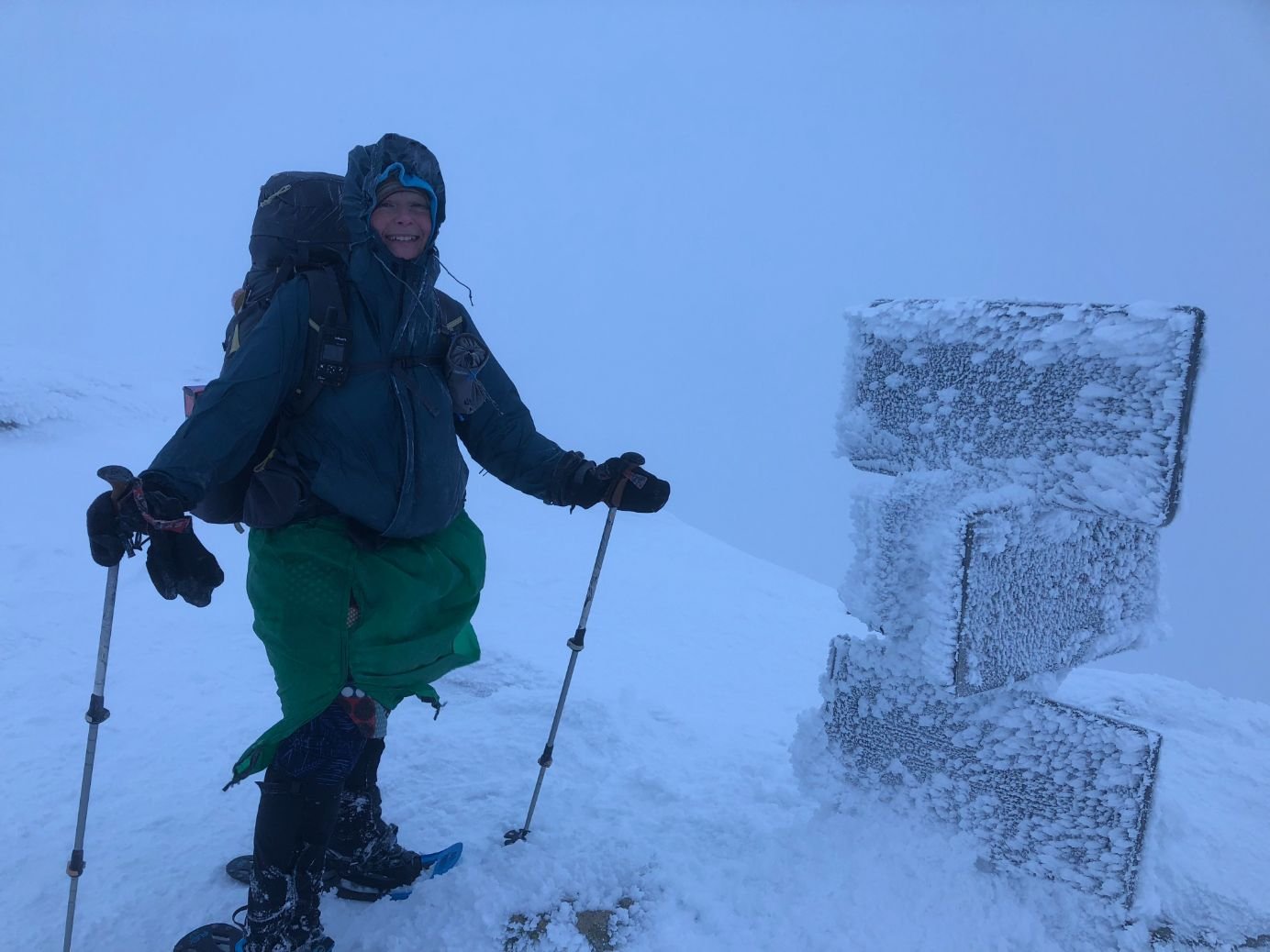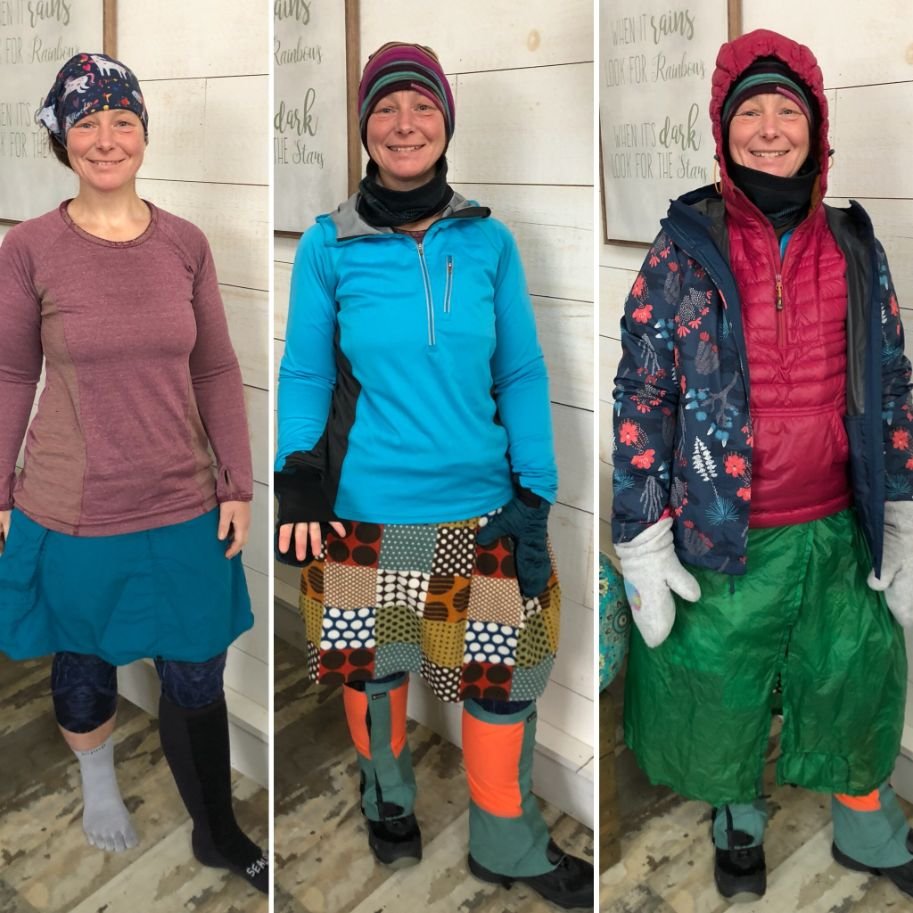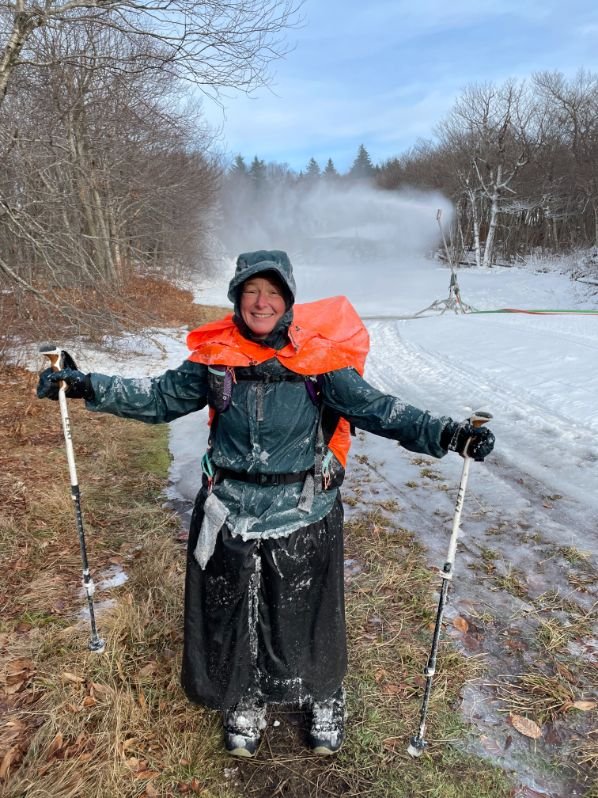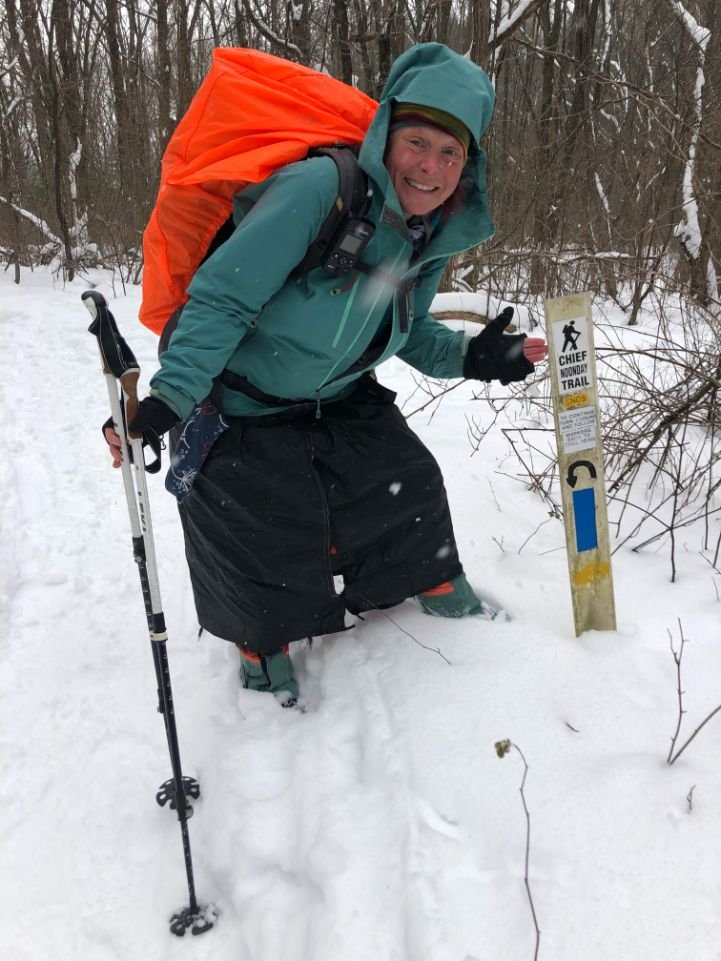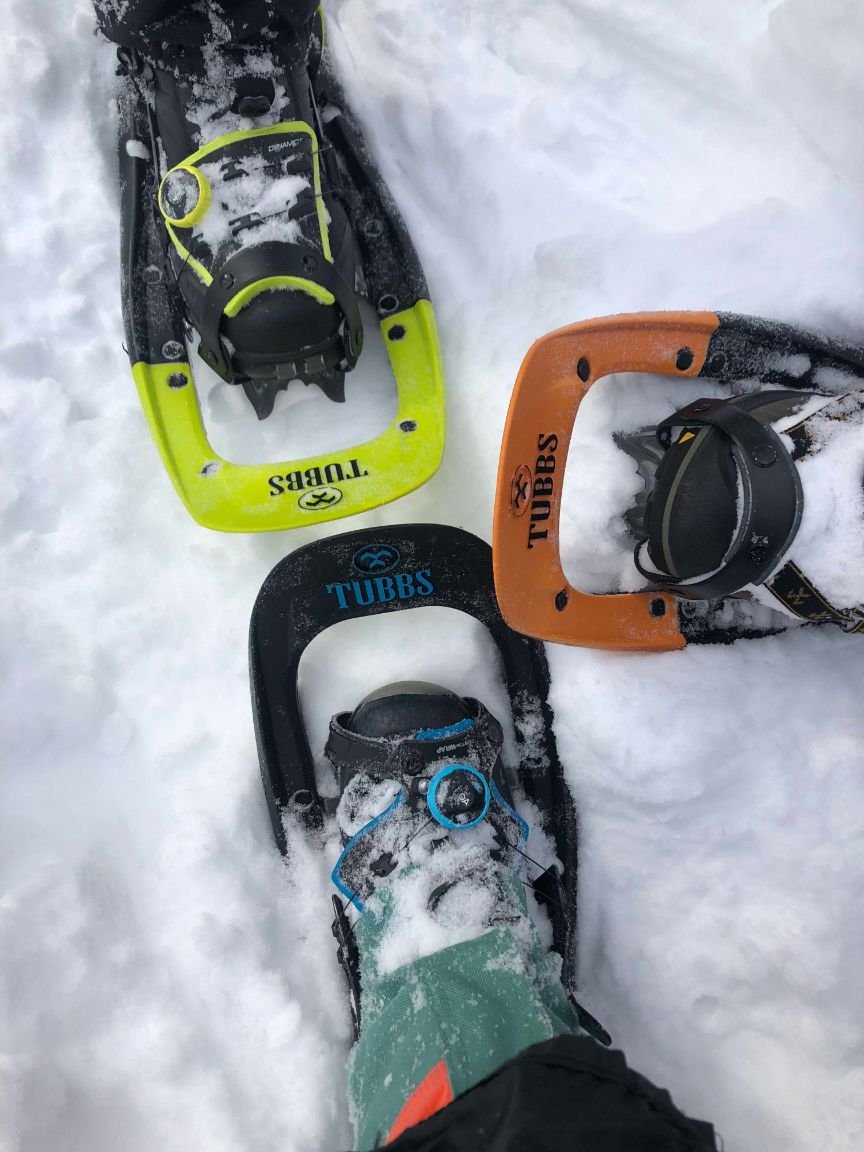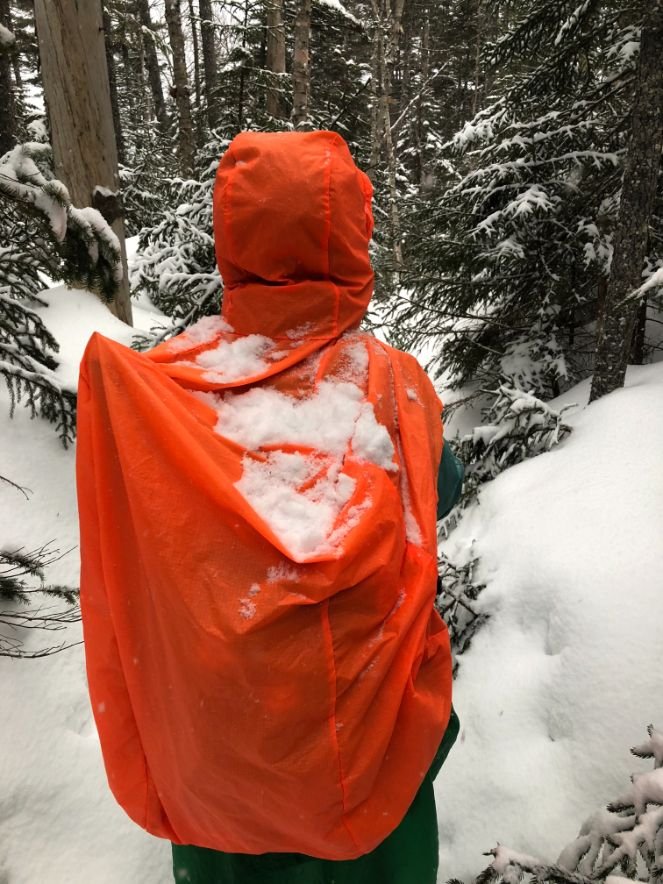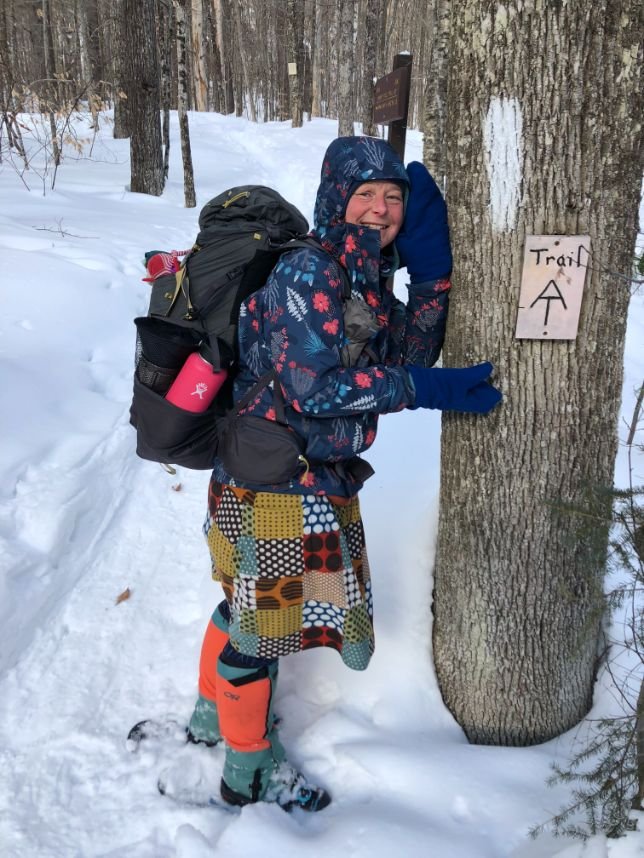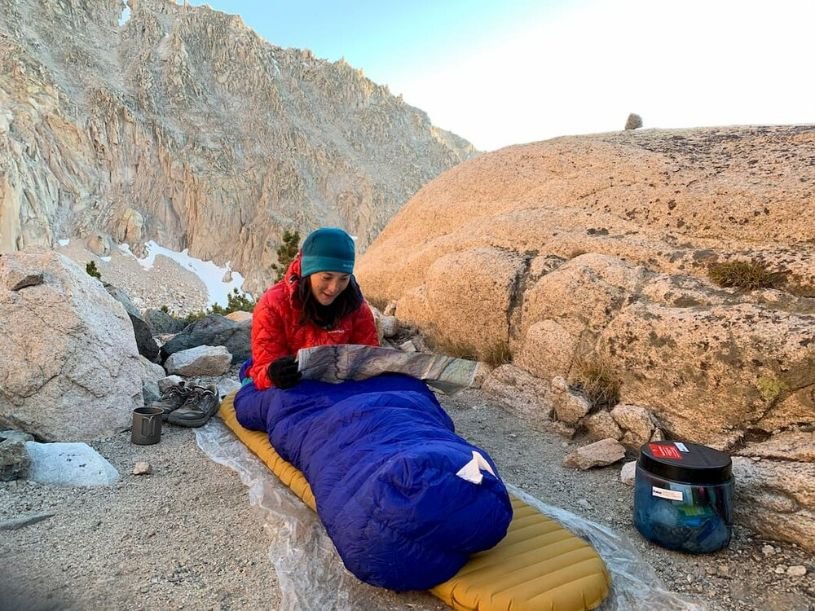What to wear winter hiking: Stay warm and dry on the trail
HOW TO Layer for WINTER HIKING AND STAY SAFE
November 9th, 2024
Home > Gear Lists
When I first started winter hiking, I didn’t know what I was doing and was frequently cold as a result. I found my wet boots frozen in the morning. From that night forward, I learned to put them in a plastic bag and tuck them in my sleeping bag at night to prevent them from freezing.
While I could get away with trail running shoes during some snowy events on my long-distance hikes, I needed something warmer and more waterproof for true winter backpacking. But even with that, I still was often uncomfortable.
So when my partner proposed hiking the 48 4,000-footers of New Hampshire in winter, I reluctantly agreed to do it in one season to get it over with quicker! He had done it before and wanted to show me the beauty of winter in the mountains. And that beauty sure is alluring.
In this story, I'll walk you through how to layer for winter hiking in cold weather. After that trip, I've since gone on to thru-hike Maine through New York during winter months on the Appalachian Trail and Michigan on the North Country Trail as the first woman to complete all 11 National Scenic Trails. Here's my trail-tested way of layering and tips for what to wear winter hiking and backpacking.
We create reader-supported, objective, independently-selected gear reviews. This story may contain affiliate links, which help fund our website. When you click on the links to purchase gear, we may get a commission, without costing you an extra cent. Thank you for supporting our work and mission of outdoor coverage for every body! Learn more.
Winter Hiking Gear Checklist
| CATEGORY | GEAR ITEM | PRODUCTS WE LIKE |
|---|---|---|
| TOPS | ||
| Base Layer | ||
| Smartwool Merino Classic Thermal (women's) | ||
| Smartwool Merino Classic All Season (women's) | ||
| Smartwool Merino Classic Thermal (men's) |
The author on Franconia Ridge in the White Mountains while winter hiking. This photo was taken on the same day as the image above, also on Franconia Ridge. Weather can change very quickly in the winter.
Why you need layering for winter hiking
The challenge of winter hiking is to explore it comfortably and, most importantly, safely. One of the critical things to achieve — besides having the right winter hiking clothing — is to learn the art of layering.
Layers are essential because one warm insulated jacket might be great when you’re not moving, but as soon as you start exerting yourself, you warm up and will start sweating–which ultimately can make you feel colder!
Manage Your Perspiration
Sweat leads to wet clothes, and wet clothes paired with cold air will chill you very quickly. The best thing to do is to wear several layers that you can bundle up with if needed, which can be easily taken off when getting too warm.
Yes, it is annoying to have to stop and adjust layers. It might take time to figure out which layers work best for you. But preventing a wet base layer is the key to safety in winter.
Manage Your Body Temperature
I might start hiking cold in other seasons because I know I’ll warm up as soon as I get moving. However, in winter, I don’t do that. When it’s -10F, I probably want to keep all my warmth; plus, it’s easier to take something off while I’m nice and cozy than to put another layer on when I’m cold and have to expend extra energy warming back up and risking cold fingers and toes.
How to layer for winter clothing from base layers to outer layer. Left photo: base layers. Middle photo: mid-layers. Right photo: Waterproof outer layers.
HOW TO LAYER FOR WINTER HIKING
Here are the winter hiking clothes I wear and how I layer them.
One thing cold weather hiking has taught me is that even though you may have fine-tuned your layering system, reassess when you go out with other hikers. Will they be slower? Consider bringing an extra layer or a warmer one. You may not exert as much energy and will not warm up as much as usual. Will they be faster? Be very wary of trying to keep up and not taking the time to adjust your layers as needed.
Next to Skin Base Layer
For next to skin winter hiking clothes, I recommend a wool or wool blend bra and shirt for base layers. Experiment with thinner or thicker layers and see what works best (I like my Lightheartgear shirt with a longer torso and thumbholes in the sleeves). Some people run hot, some cold.
I recommend carrying an extra dry wool base layer in your backpack just in case you get sweaty or fall off a slippery bog bridge in the 100-mile wilderness (I’ve seen it happen; luckily, the hiker had backup dry layers).
Related: Read about our recommendations for wicking and breathable Underwear and Sports Bras in our guides.
For winter hiking, keep your facemask, warmer mitts, and warmer hat handy for changes in weather. A down jacket and synthetic insulating jacket can help add warmth as mid layers.
Insulating Mid Layer
FLEECE JACKET
I recommend a fleece or polypro shirt/jacket over your wool base layer. See our guide to the Best Fleece jackets for more recommendations on models we like.
For a more in-depth look at layering and performance considerations, check out our Best Midlayers guide.
WIND JACKET
I prefer having that layer be somewhat windproof. I will sometimes add a light wind shell or rain jacket for wind protection. See our guide to men's windbreaker jackets or women's windbreaker jackets for examples of options for wind shells.
DOWN JACKET
If I’m still cold with those layers, I’ll add a down jacket (I like my Outdoor Research down sweater, now discontinued, since it’s nice and roomy with a hood).
I will always protect that down jacket with a waterproof outer layer in snowy conditions because if down gets wet, it loses its insulating capabilities. See more on waterproof outer layers below.
SYNTHETIC INSULATING JACKET
A synthetic jacket works a bit better in damp conditions but is usually bulkier and heavier than down. Because your down/synthetic layer and waterproof outer layer will have to fit over your other layers, you might want to size up. If your down is too tightly compressed around you, it won’t give you as much warmth.
If I have all these layers on and I’m getting too hot, the first layer I’ll take off is the down jacket. Then, I will put the water and windproof jacket back on over my fleece mid-layer.
If there is a lot of snow falling from the sky or the trees and wind is a factor but I am still warm, I may take the mid layer off next but keep on the waterproof jacket.
Weatherproof Outer Shell
I have a Gore-Tex jacket because it was pretty with pink cacti. It doesn’t breathe well, but that’s fine in winter. It has small pit zips and zippered pockets. Zippered pockets are great for stashing gloves/hats/hand warmers. See our Best Men's Ski Jackets or Best Women's Ski jackets for examples of ski hardshells. For most hiking situations, backcountry ski jackets will provide the most ventilation.
I also have a heavy Patagonia hard shell designed as a ski shell. It has a giant hood and it has more insulated lining. I only wear that outer shell in really cold temperatures because it’s bulky and heavy to backpack with. However, the lining adds warmth. I wear the waterproof hard shell to cut wind chill, add warmth and obviously when there is precipitation.
For winter hiking, layer your bottom layers with base layers, windproof mid layers, and waterproof outer layers. Here, Arlette Laan is thru-hiking Vermont and found these layers essential for winter hiking.
Bottoms
Bottom mid-layers follow the same idea as top mid-layers. I wear insulated hiking leggings with knee socks and gaiters, layered with a LightheartGear hiking skirt (with pockets!) over my bum and hips.
I use a lined capri-length pair of hiking pants paired with Darn Tough knee socks. I use the Outdoor Research Crocodile Gaiters, which are knee length.
My winter hiking partner will wear medium to heavy-weight long johns with long shorts, tall gaiters, and a rain skirt. Occasionally, he'll wear rain pants as well.
BASE LAYER BOTTOMS OR LONG JOHNS
Instead of using a single layer like winter hiking pants, ski pants, or snow pants, you'll get more versatility out of layering.
Start with a good base layer. Some hiking leggings may work here. Base layer bottoms are sometimes called long johns (but make sure they are not made of cotton). Our men's winter running tights and women's winter running tights guides have some examples of things that may work, but make sure you don't choose one that constricts too much as it can reduce blood flow and make you feel colder.
WATERPROOF OR WINDPROOF HIKING PANTS
For many situations, waterproof or windproof hiking pants over your base layer should work. See our Best Men's Hiking Pants or Best Women's Hiking pants guide for examples of waterproof or windproof options.
If you want light wind protection but not the constriction of rain pants, you could try a rain skirt (mine is from ULA Equipment).
I rarely resort to rain pants (only when I’m sinking into snow above the edge of my tall gaiters).
SKIRT OR SHORTS
I go a bit "off-market" with my layering system. I hike using a Lightheart Gear skirt. The pockets on a skirt are great for storing gloves, a hat, a buff, hand warmers, and other items that are often taken off and put back on. My hiking partner will wear long shorts over his base layers to achieve the same kind of layering and pockets.
I usually wear skirts versus pants because winter hiking pants are always tight around my bum and thighs due to my body shape. As a result, so-called “winter hiking pants” always feel cold to me. The skirt layering system allows me to have several layers insulating me from cold air.
In colder weather, I’ll layer a fleece skirt over the base skirt and add a rain skirt over the fleece as my outer layer.
Gaiters
Tall gaiters are vital in keeping snow out of your winter hiking boots and adding another layer of warmth and protection. I’ll get more into gaiters on the footwear section. If you are looking for all-around gaiters for hiking (not in snow), check out our Best Gaiters for Hiking guide.
In winter, headwear may cover almost your entire face. FYI giant pompoms on a winter hat don't layer well!
Headwear
You can lose a lot of body heat via the top of your head, so headwear is what I change most during a hike. Even when covering your head, hands, and feet, I’m a big fan of carrying different layers.
I’ll carry a buff, a light merino wool hat, and a thicker fleece hat for my head.
On very cold days and mostly above treeline, I might need a facemask or balaclava and goggles.
Make sure your balaclava has breathing holes as opposed to a closed buff. Otherwise, the moisture in your breath may wet out the fabric, which might freeze and no longer protect your face.
Gloves
For my hands, I use a thinner glove, then a pair of lighter convertible mittens, and a pair of larger fleece mittens to fit over the convertible ones.
A pair of waterproof/resistant over mitts are great for snowy days. I always have an extra dry pair of mid-weight ones in my backpack. Our guide to the Best Winter Gloves and Best Ski gloves have recommendations.
Post-holing is common during winter months. High socks and gaiters can help protect your feet and legs while winter hiking.
Hiking Boots and Socks
Socks
For backpacking trips, I use four types of socks:
medium-weight knee socks
heavy-weight knee socks
waterproof socks
Dedicated warm sleep socks
I will pick whichever pair(s) I think I’ll need for that day. And I’ll always have a warm designated pair of sleep socks. These are super fluffy hiking socks, like the Smartwool Mountaineer Socks. I also have a pair of Montbell Down Booties.
Footwear
HIKING BOOTS
I find the choice of hiking boots to be very personal, but in general, you want something waterproof and insulated.
See our guide to The Best Hiking Boots or The Best Lightweight Hiking Boots for waterproof traditional boots. Our Best Men's Winter Boots guide and Best Women's Winter Boots guide have several insulated options with good traction.
WATERPROOF SOCKS
Most waterproof hiking boots will eventually saturate, so I started wearing waterproof socks as well. I like the Sealskinz brand.
Waterproof socks aren’t always warm enough, so I line them with a medium or heavy-weight hiking sock. Make sure you have enough wiggle room with all the socks you plan on wearing. Footwear that is too tight will constrict your blood flow resulting in cold toes.
Check out our full review on the best waterproof socks on market!
The author on the flank of Mount Eisenhower in the White Mountains, NH. Photo by Kimberly Doe
how to layer for extreme cold weather
When heading above the treeline or into extreme cold weather, reassess your base layers, mid layers, and outer layer just before popping out of the protection of the trees. You may need to wear all of them.
If you’re expecting a wind chill, make sure you either put some extra layers on or have them handy, so you don’t lose body heat unnecessarily.
Things I keep handy are my facemask, warmer mitts, and warmer hat.
Snowshoeing up a steep slope with heel lift employed. Photo by Rich Gambale
Using Hillsound Trail Crampons and an ice axe on a more exposed slope with harder snow.
TRACTION FOR WINTER HIKING
During 3-season hiking, you usually know what to expect when it comes to the trail conditions. In winter, they may vary. Is there fresh snow? You’ll want snowshoes. Was there a recent melt followed by freezing temperatures? You’ll want some sort of specialized winter hiking gear for maintaining traction in icy conditions. Here's how I choose.
Arlette and two other hikers compare their snowshoes for winter hiking.
Snowshoes
When picking out snowshoes, you’ll want to look at the terrain you’ll be using them for. If you are going up steep, sometimes icy inclines, a snowshoe with an aggressive crampon system and a heel lift are necessary. You can go with a simpler version if you're just hiking some mellow terrain.
Sizing depends on the amount of weight they need to support. If you’re carrying a heavy backpack, you might want to add that to your body weight and size up on the snowshoe. The bigger the shoe, the more flotation you’ll get, but be careful not to go too big. Big snowshoes are cumbersome. I went smaller than my weight suggested, as the shoes got too clunky to use.
If you know you’ll be mainly hiking on trails that will already be broken out, you don’t need as much flotation either. Sometimes you can even make do with just spikes. But keep in mind that it is common courtesy not to ruin a beautifully laid snowshoe track by using spikes and leaving postholes.
If you’re new to snowshoeing, we highly recommend learning basic snowshoeing skills before you head out.
Arlette Laan on her thru-hike of the North Country Trail. Here, she found the trail to be completely iced over and required spikes.
Traction devices
When it comes to spikes, there are different categories. Kathoola MICROspikes are great for medium traction. Hillsound Trail Crampons have a more aggressive spike, which is great for the steeper, icier terrain. True mountaineering crampons have the most aggressive spikes.
There are true crampon brands that will fit on a softer hiking shoe or hiking boot, but some are only fit for a mountaineering boot, so watch for that if/when looking to buy some.
True crampons will give you traction in steep icy conditions. But as a hiker, I’ve rarely needed them.
When planning your hike, research online and find out what the trail conditions are. For a Mount Washington, NH summit bid, you will probably need crampons if you ascend via the Lion Head route, but you may be okay without them coming from Crawford Path. A little research goes a long way in winter.
Before using crampons, I recommend learning how to use them before you set out on your planned hike. Watch some youtube videos, take a class, or find an experienced friend. The same goes for the use of an ice axe. Crampons and ice axe can be dangerous if you don’t know how to use them properly. See our guide to the Best Winter Traction (microspikes and crampons) for more recommendations.
Rich Gambale brings a headlamp for winter hiking because days are shorter and nights are longer.
OTHER WINTER HIKING GEAR
Sunglasses
A beautiful blue bird day above treeline in the winter is fantastic but comes with added challenges. The challenge is the bright sun reflected back by the bright snow. It can be so intensely bright my eyes won't be able to handle it and it can lead to snow blindness. The bright snow reflecting back requires good eye protection. Darker sunglasses are a must and it’s best if you have bigger ones to prevent sunlight from coming in from the side. See our Best Running Sunglasses guide for recommendations on options that we like.
Glacier glasses have a piece of material attached to cover up any gaps. Proper goggles will give the best protection. Goggles are the best when it comes to cold and wind as well. Those frozen eyelashes look beautiful in photos, but your eyes will be happier when you prevent that from happening. However, the glacier goggle tan or sunburn also doesn’t look as great in photos.
Sunscreen
Bring plenty of sunscreen! See our Best Face Sunscreen for options we like. Although it's unlikely you'll need body sunscreen, if your skin is less sensitive, you may be able to use less expensive body sunscreen options as well.
Headlamp
There are many reasons to have a good headlamp for winter hiking. Daylight in winter is in short supply. You may move slower in winter because of snowy conditions and a heavier pack. A hike that typically has you back before dark may have you hiking out after the sun goes down.
For winter, either plan shorter hikes or bring many backup batteries for your headlamp. You might even bring an extra headlamp as backup. See our guide to The Best Headlamps for recommendations.
Trekking Poles
If you’re not one of those hikers who uses trekking poles in summer, you may want to rethink this for winter.
Snowshoeing, in particular, can throw your balance off. With conditions possibly being slick, it’s helpful to have the poles for stability. I also like to use mine to push the snow off branches ahead of me and gauge ice's solidity when crossing frozen streams.
For winter, I recommend aluminum poles with a flick lock system. In my experience, these are stronger and the flick lock system is less likely to collapse when wet. I use a pair of women's Leki poles with a cork handle for winter. See our guide to The Best Trekking Poles for recommendations.
A Lightheart Gear Hoodie Pack Cover can protect your back and pack from snow while winter hiking.
Hoodie Pack Cover
One piece of hiking gear that I’ve also really enjoyed in the winter is the Lightheart Gear Hoodie Pack Cover. When your trekking pole doesn’t effectively remove the snow on the branches, it will most likely fall on your neck. And even if you have a jacket with a hood on, your neck and shoulders will soon become saturated. The pack cover hoodie has served me well as a light extra protective layer for that area.
Handwarmers
I may open up a pair of hand warmers if I need them. I'll take them out when I expect it to get so much colder, such as when I'm about to head above treeline and know that I’ll need some extra warmth.
Handwarmers warm up faster when wind chill isn’t cooling them off. They work very well for me in combination with my flip-over mittens, but be aware that you may get a pair that doesn’t work every once in a while. I carry some extras and always have the warmer mitts available if needed.
Related: read our full guide to winter backpacking for more tips on staying warm.
Example of break time on winter hiking. Bring a thin insulated pad to sit on as well as an insulated water bottle to drink hot water.
FROSTBITE & HYPOTHERMIA: How to avoid them and what to do when you feel cold
So what happens when you don’t have the proper gear?
Basically, you get too cold.
Next, your body will focus all its energy on keeping your core warm, leaving your extremities vulnerable to frostbite. Tissue might freeze because blood is shunted away from the cold areas of the body. Fingers, toes, and noses are usually in danger. When your fingers and toes go from cold to numb, address it immediately.
You can learn more about staying safe while hiking in the snow in our risk assessment and decision making and the section on Traveling in the Cold as well as skills to learn.
What To Do When You Feel Cold When Hiking
Here are tips that work for us:
Add on layers.
Make sure your hiking clothing, winter boots, and crampons aren’t too tight. You want to be able to wiggle your toes for good circulation.
If you have wet layers, change them out for dry ones.
It gets tricky if movement doesn’t warm you up and the extra layers don’t help. A movement like hiking, jumping jacks, rubbing your hands together, or wiggling your toes can all help.
If you have overnight gear, set up camp, and get in a sleeping bag.
Have someone help warm you up. Skin-to-skin works best. I’ve put my cold hands on someone’s warm belly, and while it’s not pleasant for the other person, it definitely worked.
Remember that food is fuel for your body to stay warm and energized. Pack foods that are easy to eat in cold temperatures, such as soft cheeses, meats, M&M’s, etc. (not Snickers, they freeze). I like to pack an insulated bottle with a hot drink; cocoa, chai tea, or hot water with a NUUN tablet. Drinking cold, half-frozen water is fun in the heat of summer, but it’s the last thing I want to drink when trying to maintain my body heat. I prefer a Hydro Flask bottle with a flat lid for keeping things really hot.
What to Know About Frostbite
Severe frostbite consists of numb, cold, white, rock-hard skin with big blisters (blebs). It shouldn’t be field rewarmed since the area will be useless and very painful; evacuation is the only option. Know the signs and read up on what to do before you go.
Dangers of Hypothermia
A danger from cooling off too much is hypothermia. What happens is that your body’s core gets so cold that your normal brain and muscle function are impaired. While the symptoms may be evident to others, it’s hard to notice this happening in yourself. You may start mumbling and stumbling; your brain isn’t all there. You might leave food, water, and shelter behind. Your decision-making capabilities are impaired. Eventually, you start shivering uncontrollably and are unable to walk. The lower your body temperature, the less you can function. When your body temperature reaches around 86F, you lose consciousness, your skin is ashen grey, and you may appear pulseless and breathless.
Know the signs and read up on what to do to prevent hypothermia before you go.
Prevention and treatment for hypothermia are basically the same as for frostbite. Keep warm! Use dry, warm layers. Stay hydrated and fueled. Powdered JELL-O dissolved in warm water is often recommended since it is easy for people to ingest. If someone is experiencing these symptoms, get them out of the elements, stop the heat loss, and keep them fueled. Consider calling for evacuation.
Real Life Example
I have had numb toes from too-small boots and had to stop hiking; I couldn’t put extra socks or toe warmers on because I didn't have any more room in my shoes. I actually put toe warmers in my shoes and it didn't help at all since I had less room to wiggle my toes. My boots were freezing up from dropping temperatures after a thaw. We stopped and set up camp, my feet warmed up in my sleeping bag, and I was fine after that.
While fingers and toes are relatively easy to keep in check, the nose is slightly less obvious. I’ve had the early stages of frostbite (frostnip) happening to my nose but I never felt it go cold or numb. My partner spotted it looking waxy, and I quickly warmed it up. I warmed it up by pinching it, blowing my breath towards it while covering it with my hands and then protecting it with a Buff. Awareness of potential cold temperature-related dangers is one of the many reasons I prefer hiking with a partner in winter, especially above treeline.
WINTER HIKING TIPS
Don't Wear Cotton
You’ve heard this before, cotton kills. While this is exaggerated, and cotton has its place in summer hiking, it is to be avoided for winter. When wet, it does not keep you warm and takes a very long time to dry. Save it for desert hiking. Use wool for base layers and socks.
Don't Let Your Drinktube Freeze
For those who love their water bladders and drink tubes, just don’t. There are insulation systems, but in my experience, they don’t work in winter conditions. You only need a little bit of ice in there to block up the tube and mouthpiece. I suggest insulated bottles (Hydroflask with a flat lid is my favorite) or a Nalgene bottle with an insulated cover.
The Nalgene is great for camping since you can put hot water in it and use it to warm up your sleeping bag at night. Just make sure to close it tightly. A hot water bottle is lovely at the end of a cold day. See our guide to The Best Hiking Water Bottles for more recommendations.
Keep Your Batteries Warm
Cold temperatures aren’t your (phone) battery's friend. Keep them in a warm pocket, stashed away, or perhaps put them in your sleeping bag at night. I’ve seen my phone die many times in the cold, and I’ve learned my lesson. I keep it in a pocket in my mid-layer. Is it a hassle to dig it out? Yes. But at least I can still take pictures every once in a while. It gets trickier when you want to use your phone for navigation, so carry those paper maps!
Bring a Satellite Communicator
A satellite communicator like a Garmin inReach does much better when retaining battery power than cell phones. I like carrying mine especially in winter when the trails are less populated.
If you’re going solo, I recommend using the tracking feature so people at home can follow along and pinpoint you when something goes awry. They have been known to give faulty waypoints when activated in cold and mountainous areas, so having it already track you in real-time will give rescuers more certainty on your location.
Be Prepared to Stay Overnight
And call me overly cautious, but even on winter day hikes, I’ll carry overnight gear.
On winter hikes I carry a:
These items may not keep me as warm and cozy as my full-on winter overnight gear, but they may save my life if I get stuck for the night.
I recommend having a hiker partner in winter, especially when hiking above treeline. You will be able to keep an eye on each other. You can check each other for frost nip on your nose and notice odd behavior indicating hypothermia. And from experience, stepping in a spruce trap was less harrowing since I had someone there to pull me out.
Be Prepared
Last but not least, BRING YOUR COMMON SENSE!
Check the weather, pay attention to the wind chill forecast, and bring the right gear. But don’t get so distracted by your goal that you don’t properly assess the conditions while you’re out there.
WHEN IN DOUBT, TURN AROUND!
Arlette Laan hiking on the Appalachian Trail in the winter.
About the author / why you should trust us
Arlette Laan is the first woman to hike all 11 National Scenic Trails in the US. She's also set the Fastest Known Time for the White Mountain Direttessima. She is a certified wilderness first responder and guide with Redline Guiding in New Hampshire.
She’s hiked New Hampshire’s 48 4,000-footers in the winter season of 2018/19; she even hiked them all again as a continuous backpacking trip in the winter of 2019/20.
In the winter of 2020/21, she hiked on (or near) the Appalachian Trail from Baxter Peak to the New Jersey border, and she hiked the North Country Trail in Michigan in December 2021 and January 2022.
She hiked these all with her companion Rich Gambale who taught her winter skills while she could safely figure out her layering system. Without him, she may have never come to embrace winter hiking, and she is thankful for all her amazing adventures. You can read about Arlette at her website arlettelaan.com.

